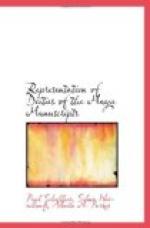Finally it should be mentioned that the head of this bird occurs frequently as a head ornament, thus in Dr. 11a, 11b, 12b and 14b. Mention should also be made of the realistic representations of the vulture, eating the eye of a human sacrifice (Dr. 3, Tro. 26*a and 27*a).
According to Foerstemann his day is Cib.
5. The Jaguar.
[Illustration: Fig. 62]
The jaguar is likewise an animal with mythological significance. It is represented in Dr. 8a, where its hieroglyph is the third sign in the writing; it also occurs in Dr. 26 (at the top). It occurs in Tro. 17 (at the end) with a hieroglyph which represents the jaguar’s head and contains the numeral 4 (Fig. 62); again it appears without a hieroglyph on p. 20 (bottom) and on 21 and 22 (bottom).
Its day is Ix, and hence it also relates occasionally as year regent to the Ix years, for example in Dr. 26a.
6. The Tortoise.
[Illustration: Figs. 63-65]
This animal, like the dog, appears as a lightning-beast (see Dr. 40b, middle). Its hieroglyph is Figs. 63, 64. This sign also is connected with the numeral 4, which occurs so often with animals (but not alone with quadrupeds) as to be worthy of attention. The sign of the tortoise without the numeral is seen in Cort. 17a, where the tortoise itself is also represented. It must have reference to the 17th month of the Maya year, for the month Kayab (and apparently also Pop) contains the head of the tortoise (compare Fig. 65). It occurs several times in the Cortesianus, thus on pp. 13, 19, 37, 38; on p. 19 with the hieroglyph (on the top of the lower half of the page, 1st line and at the right of the margin). In Dr. 69 (at the top) we see the sign of the tortoise with the Kin-sign as its eye and the numeral 12; under this group B, with a black body, is seated on the serpent; on the same page the sign occurs again; each time, moreover, apparently as a month-hieroglyph.
According to Foerstemann the tortoise is the symbol of the summer solstice, as the snail, which occurs only as a head ornament in the manuscripts and not independently, is the symbol of the winter solstice; both, as the animals of slowest motion, represent the apparent standstill of the sun at the periods specified. This explains why the month Kayab, in which the summer solstice falls, should be represented by the head of a tortoise, which has for its eye the sun-sign Kin (Foerstemann, Zur Entzifferung der Mayahandschriften III, Schildkroete und Schnecke in der Mayaliteratur, Dresden 1892).
According to Foerstemann its day is Cauac.
* * * * *




